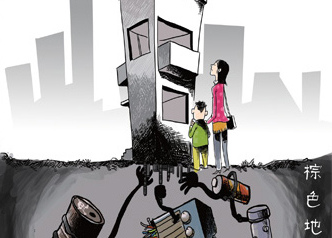
No one wants to live near a garbage dump, but how would you feel if you found out your home was built on toxic soil?
(Ecns.cn) – Many people in China are unaware that they live in apartment blocks built on "brownfield" sites where polluted soil can cause health problems, reports Caijing Magazine.
In recent years, numerous contaminated sites have been redeveloped into residential communities in China, but some of those projects were completed without proper extraction of pollutants in the soil and groundwater beneath them.
Between 2001 and 2005, a total of 142 factories were relocated in Beijing, but less than 20 of their former locations were listed as brownfield sites, and only eight underwent soil reclamation, notes Caijing Magazine.
For the time being, the government has an alarming lack of information about the true state of brownfields all over the country. Yet with more and more health hazard cases arising due to toxic soil, solutions to the problem can no longer be delayed.
Poisoned workers
In April 2004, three construction workers suddenly fainted while working in an underground subway project near Songjiazhuang Station in Beijing and were immediately hospitalized.
The project was located at the site of a former insecticide factory. The workers had all been poisoned by pesticide, and one of them was so ill he reportedly required hyperbaric oxygen chamber therapy.
In July 2006, six road construction workers each lapsed into a coma in Guoxiang of Suzhou, Jiangsu Province. Investigations revealed that the construction area had been left behind by a chemical company and that the soil was heavily polluted.
In October 2010, a resident living in an affordable housing project in Wuhan, capital of Hubei Province, fell ill only a few days after moving in. The next day he learned from reading the news that his house was located on a brownfield site contaminated by chemicals.
Because such cases are increasingly common in China's modern cities, construction workers have been forced to educate themselves about toxic soil.
Last month, workers were so overwhelmed by a pungent odor at the construction site of a residential community in Guanzhuang of Beijing's Chaoyang District that they demanded the project developer excavate and relocate the soil from the area.
The site was formerly the location of a factory where wooden railroad ties, or sleepers, were produced for over 30 years. After the factory moved elsewhere, the soil in the area remained heavily polluted with chemicals used to prevent wood from decaying, according to Caijing Magazine.
Underground water and even deeper parts of the area were all contaminated. Nevertheless, a residential community project involving several high-rise apartment buildings was slated for construction atop the derelict site, and no one would know what was buried underneath.
Hazardous reclamations
A subsequent report on the construction site in Guanzhuang released by the Chinese Research Academy of Environmental Sciences (CRAES) sent shockwaves through the public.
According to the report, soil and water samples taken from the site on March 21, 23 and 24 revealed pollutants far over the limit, including alarming levels of polycyclic aromatic hydrocarbons, which are highly carcinogenic and mutagenic.
Moreover, as soil and underground water have mixed together over the years, water deep below ground has also become heavily polluted. The report says that excessive pollution can still be observed in areas about 12 meters deep.
Currently, China still relies on the most common process of excavation and dredging, or "dig and dump," to extract contaminated soil deemed unrecoverable. The bad soil is transported to a landfill, and purified soil is used to fill in the area where the extraction took place.
But such methods are not effective in treating polluted soil, let alone contaminated underground water, experts say. Because of this, many land reclamation projects are dangerous due to a lack of specialized facilities and advanced technology.
Most Chinese remediation companies are still in their infancy, which makes cleaner techniques difficult to implement, explained Liao Xiaoyong, vice head of the Institute of Geographic Sciences and Natural Resources Research (Chinese Academy of Sciences).

Copyright ©1999-2011 Chinanews.com. All rights reserved.
Reproduction in whole or in part without permission is prohibited.